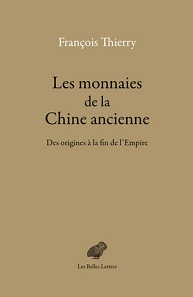by Ursula Kampmann
translated by Annika Backe
September 14, 2017 – Hardly any monetary history is as varied, intriguing, and amazing as the history of Chinese currency. It ranges from the cowrie, via all the knife money, spade money, and ant-nose coins, up to the Chinese cash made of bronze, and the private gold and silver bars that supplemented the standardized silk fragments for paying larger sums of money. Then there is the introduction of money that was made of paper, a measure that was unbelievable by the standards of the time! China is the trendsetter of fiat currency of any kind. And last but not least there is the conversion of a whole national economy to a system of coinage modelled on the West. The history of Chinese currency has so much to offer – it’s a pity that there are only so few books available that reach a certain level when dealing with this topic.
François Thierry, Les monnaies de la Chine ancienne. Des origines à la fin de l’Empire. Paris 2017. ISBN 978-2-251-44686-8. 688 pages. 369 illustrations. 20 maps and charts. 16.5 x 24.5 cm. Thread stitching. Paperback. 55 euros.
For all those who master the French language, there has been a new standard work of reference been released that can be accessed on all these aspects in the future. François Thierry has written a handbook that spans about 700 pages. From the beginnings in the distant past and the use of the cowrie up until the end of the Chinese currency system. Nobody who wants to engage in Chinese means of payments in a substantiated way will be able to do without this book.
François Thierry, who we introduce in our Who’s who on this occasion, is considered THE expert in Chinese coins. Since the 1980s, he has dealt with the coins of the Far East, and has been responsible for this area, which the West often neglects, at the Bibliothèque national since 1989. His retirement in 2015 has provided him with the time to author his magisterial standard work of reference on Chinese numismatics.
The volume is arranged in 16 large chapters: 1.) From the beginnings to the end of the Warring States; 2.) Monetary unification; 3.) The currency of the Han; 4.) The Confucian revolution; 5.) From the restoration to the crisis of the 3rd and the 4th centuries; 6.) Money and circulation in the era of the division; 7.) The Tang dynasty; 8.) The five dynasties and the ten kingdoms; 9.) Money and circulation under the Song; 10.) The four dynasties: Liao, Xi Xia, Jin, and Yuan; 11.) The Ming and the Southern Ming; 12.) The end of the traditional system; 13.) Paper money in China; 14.) The units of account; 15.) Epigraphy and calligraphy; 16.) Production.
In his reconstruction of the monetary history of China, the author uses not only the objects but investigates the great number of written sources, too. These are available in abundance, even if we Westerners do not usually know them – for obvious reasons. It is important to remember that China was a country of scholars and scribes, who sent detailed memoranda to the court with their reports on anything related to money and coins.
The bibliography proves this work to be highly substantiated. It spans 65(!) pages and largely contains Chinese essays and monographs. This manual thus gives the reader a survey of the state of research in China.
For those who are somewhat afraid of French: François Thierry is by no means a fan of literary pomposity and complicated multi-clause sentences. His French is easy to understand and can certainly be mastered with the French you learned at school, a dictionary, and a great deal of enthusiasm. Anyone who dares to do so will be rewarded with a wealth of knowledge that enables him or her to understand and appreciate the subtleties of Chinese monetary history.
You can buy the book here and have a look at its table of contents.
It is also available for download, as an e-book for €38.
You can learn more about François Thierry in his Who’s who entry.





